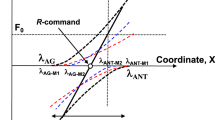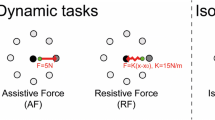Summary
Subjects performed two patterns of coordination between the elbow and wrist joints of the right arm: 1) wrist flexion synchronized with elbow flexion and wrist extension with elbow extension (homologous muscle groups); and 2) wrist extension synchronized with elbow flexion and wrist flexion with elbow extension (non-homologous muscle groups). As a parameter, cycling frequency, was increased, an abrupt switch in the phase relation between the elbow and wrist joints occurred. Similar effects were observed in underlying neuromuscular (EMG) timing patterns. Observed transitions depended on whether the forearm was prone or supine, not simply on the muscle pairing across the joints. With the forearm supine, transitions were from pattern (2) to pattern (1) above, and with the forearm prone the transitions were from pattern (1) to pattern (2). When subjects were initially prepared in pattern (1) with the forearm supine or in pattern (2) with the forearm prone, switching did not occur. En route to transitions, enhanced fluctuations in the phase relation occurred, indicating that loss of stability is at the origin of pattern change. Accompanying such changes in coordination were characteristic effects on end effector trajectories and velocity profiles. Possible neurophysiological mechanisms for context dependence in multijoint coordination are discussed.
Similar content being viewed by others
References
Abend W, Bizzi E, Morasso P (1982) Human arm trajectory formation. Brain 105:331–348
Asatrayan DG, Feldman AG (1965) Functional tuning of the nervous system with control of movements or maintenance of a steady posture. I. Mechanographic analysis of the work of the joint on execution of a postural task. Biophysics 10:925–935
Baldissera F, Cavallari P, Civischi P (1982) Preferential coupling between voluntary movements of ipsalateral limbs. Neurosci Lett 34:95–100
Bishop A, Harrison A (1977) Kots and Syrovegin (1966) — A Demonstration of modular units in motor programming? J of Hum Mov Stud 3:99–109
Flash T, Hogan N (1985) The coordination of arm movements: an experimentally confirmed mathematical model. J Neurosci 5:1688–1703
Forssberg H, Grillner S, Rossignol (1977) Phasic gain control of reflexes from the dorsum of the paw during spinal locomotion. Brain Res 132:121–139
Georgopoulos AP, Grillner S (1989) Visuomotor coordination in reaching and locomotion. Science 245:1209–1211
Granit R (1977) The purposive brain. MIT Press, Cambridge
Haken H (1983) Synergetics, an introduction: non-equilibrium phase transitions and self-organization in physics, chemistry and biology. Springer, Berlin Heidelberg New York
Haken H, Kelso JAS, Bunz H (1985) A theoretical model of phase transitions in human hand movements. Biol Cybern 39:139–156
Hogan N, Flash T (1987) Moving gracefully: quantitative theories of motor coordination. TINS 10:170–174
Jeannerod M (1984) The timing of natural prehensile movements. J Mot Behav 16:235–254
Kelso JAS (1977) Motor control mechanisms underlying human movement reproduction. J Exp Psychol Hum Perc Perf 4:529–543
Kelso JAS (1984) Phase transitions and critical behavior in human bimanual coordination. Am J Physiol [Reg Integ Comp] 15:R1000-R1004
Kelso JAS, Delcolle JD, Schöner G (1990) Action-perception as a pattern formation process. In: Jeannerod M (eds) Attention and performance, XIII. Erlbaum, Hillsdale NJ, pp 139–169
Kelso JAS, Scholz JP, Schöner G (1986) Non-equilibrium phase transitions in coordinated biological motion: critical fluctuations. Phys Lett A 118:279–284
Kelso JAS, Southard DL, Goodman D (1979) On the nature of human interlimb coordination. Science 203:1029–1031
Kots YM, Syrovegin AV (1966) Fixed set of invariants of interaction of the muscles of two joints used in the execution of simple voluntary movements. Biofizika 11:1061–1066
Kots YM, Krinskiy VI, Naydin VL, Skik ML (1971) The control of movements of the joints and kinesthetic afferentation. In: Gelfand M, Gurfinkel VS, Fomin SV, Tstelin ML (eds) Models of functional organization of certain biological systems. MIT Press, Cambridge, pp 371–381
Lacquaniti F (1989) Central representations of human limb movement as revealed by studies of drawing and handwriting. TINS 12:287–292
Lacquaniti F, Soechting JF (1982) Coordination of arm and wrist motion during a reaching task. J Neurosci 2:399–408
Lacquaniti F, Soechting JF, Terzuolo CA (1982) Some factors pertinent to the organization and control of arm movements. Brain Res 252:394–397
Morasso P (1981) Spatial control of arm movements. Exp Brain Res 42:223–227
Polit A, Bizzi E (1979) Characteristics of motor programs underlying arm movements in monkeys. J Neurophysiol 204:443–460
Schmidt RA (1987) Motor learning and control: a behavioral emphasis. Human Kinetics, Champaign IL
Schmidt RC, Carello C, Turvey MT (1990) Phase transitions and critical fluctuations in visually coupled oscillators. J Exp Psychol Hum Perc Perf 16:227–247
Scholz JP (1989) Reliability and validity of the WATSMART™ 3-D optoelectronic measurement system. Phys Therapy 69:679–689
Soechting JF (1984) Effect of target size on spatial and temporal characteristics of a pointing movement in man. Exp Brain Res 54:121–132
Soechting JF, Terzuolo CA (1986) An algorithm for the generation of curvilinear wrist motion in an arbitrary plane in three-dimensional space. Neuroscience 19:1393–1406
Uno Y, Kawato M, Suzuki R (1989) Formation and control of optimal trajectory in human multijoint arm movement. Biol Cybern 61:89–101
Viviani P, Terzuolo C (1980) Space-time invariance in learned motor skills. In: Stelmach GE, Requin J (eds) Tutorials in motor behavior. Elsevier, North-Holland, Amsterdam, pp 525–533
Wann JP (1989) The appraisal of the velocity-curvature relation in children's hand movements: a research note. J Mot Behav 21:145–150
Author information
Authors and Affiliations
Rights and permissions
About this article
Cite this article
Kelso, J.A.S., Buchanan, J.J. & Wallace, S.A. Order parameters for the neural organization of single, multijoint limb movement patterns. Exp Brain Res 85, 432–444 (1991). https://doi.org/10.1007/BF00229420
Received:
Accepted:
Issue Date:
DOI: https://doi.org/10.1007/BF00229420




